Australia’s wild weather is no joke — from flash floods in Queensland to power outages during summer storms. If you’re running a Shopify store, one severe weather event can cause serious disruptions. Website downtime, lost orders, corrupted data… these are risks you can’t afford.
Let’s break down how to bulletproof your Shopify store’s security against natural disasters — and keep selling rain, hail, or shine.
Why Disaster-Proofing Your Store Matters in Australia
With more frequent and intense climate events, every online store needs a disaster recovery plan. Not just big retailers — even small e-commerce businesses face major risks if their data isn’t backed up and secure.
👉 Create your Shopify store today and set it up with protection from day one.
1. Automate Daily Backups
Shopify doesn’t provide native full-site backups, so you’ll need a third-party app. Top choices include:
- Rewind Backups
- Vault
- BackupMaster
These apps automatically back up your product listings, theme files, customers, and orders. You can restore your store to a previous version in minutes if something goes wrong.
👉 Set up your Shopify store and install a backup app before the next storm hits.
2. Use Cloud-Based Tools and Integrations
Make sure your essential tools (accounting, shipping, email marketing) are cloud-based and integrated with Shopify. This way, you won’t lose important data if your device or internet connection fails during extreme weather.
👉 Choose Shopify-compatible apps that support remote access and automatic syncing.
3. Activate 2FA and Staff Permissions
Security breaches often happen during power outages or system failures. Enable two-factor authentication (2FA) and assign limited roles to staff. That way, if your team is working remotely during a disaster, you control what they can access.
👉 Secure your Shopify account with built-in tools and permissions.
4. Use Shopify Payments with Local Reliability
During floods or infrastructure outages, many third-party gateways may experience issues. Shopify Payments is tightly integrated and generally more stable during local disruptions. Plus, it supports Aussie methods like Afterpay and Zip.
👉 Enable Shopify Payments for faster, more resilient transactions.
5. Optimise for Mobile Recovery
Customers will likely use mobile devices if they lose power or can’t access desktop connections. Your store should be lightning-fast, mobile-responsive, and easy to navigate.
👉 Pick a disaster-ready Shopify theme and test your store across devices.
6. Communicate Fast with Customers
Set up automated email and SMS notifications for delays or disruptions. Apps like Klaviyo or SMSBump let you send out instant alerts to keep customers in the loop.
Bonus Tip: Create a temporary homepage banner to announce delivery changes or extended support hours during emergencies.
👉 Start your Shopify store and stay connected even during a blackout.
Natural Disaster? Your Store Doesn’t Have to Go Down with It
The climate may be unpredictable, but your business doesn’t have to be. By setting up backups, securing your data, and preparing for remote operations, you can weather any storm — literally.
👉 Get started for free and make your Shopify store disaster-resilient from day one.







